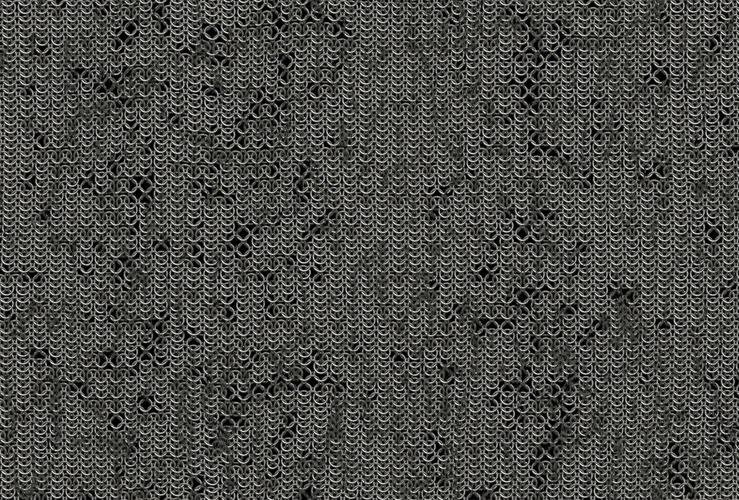Scientists, writing in the journal Nature, have developed a smart fabric, inspired by chainmail, that can change its properties from flexible to hard when it is subjected to pressure. Put simply, the newly designed chainmail fabric is flexible and can be easily folded in normal conditions but becomes stiffer under pressure. This article discusses the development and importance of this newly developed smart fabric inspired by chainmail fabrics.

Image Credit: Alexander A. Nedviga/Shutterstock.com
What is a Smart Fabric?
Smart fabrics are those fabrics that can sense and respond to external stimuli by varying their properties. These are wearable fabrics that can be applied to medical monitoring, energy harvesting, and wearable computing. Smart textiles are often integrated with advanced components, for example, flexible electronic circuits for sensing and computing, or phase-changing materials for thermal regulation.
Smart fabric with advanced adaptable or tunable mechanical properties could be applied in the medical field such as providing external joint assistance, and haptic perception in vulnerable humans.
New smart fabrics are created based on the structured fabric used in various pre-existing materials such as medieval chain mail armor and Kevlar sheets. Some fabrics possess a wide range of unique properties that include heat regulation, high impact resistance, and electrical conductivity. These properties could be incorporated into new fabrics via customized combinations of material properties and component geometries.
Chainmail Fabric
Yifan Wang and colleagues at Singapore’s Nanyang Technological University and the California Institute of Technology developed a material that is a high-tech version of the chain-mail armor used by medieval knights. The research team re-evaluated the mechanics of chain mail, particularly focusing on the jamming transition, and developed a new fabric with advanced properties.
The newly developed material can become more than twenty-five times as hard as its original state under pressure. Other important characteristic properties of this material are its lightweight, tunability, and ability to retain a fairly flat shape. Scientists used computer simulations to evaluate the factors that could influence these mechanical properties. This fabric was created by 3D printing chainmail from a nylon plastic polymer.
The material consists of hollow octahedral subunits (centimeter-sized) that interlock, without losing their ability to move against one another. Octahedrons interlock with their adjacent octahedron subunits such that they were rotated 90 degrees from one another and connected at the corners.
To subject this material under pressure, researchers packed this fabric material in a plastic bag from which air was pumped out. Therefore, the pressure on the structure matched the difference between the external and internal pressures.
How Has Jamming Influenced Chainmail Fabric Properties?
As stated above, the main property of this fabric is that under normal conditions it can be folded and deformed into various complex shapes. However, when they are encased in a flexible plastic envelope and then compacted by evacuating the envelope, their property changes and becomes stiff. This shift in properties occurs due to a process known as “jamming.”
Further Reading - Metafabrics: Smart Fibers Can Shield Vehicles from Heat as Climate Changes
On application of pressure to the fabric material, the packing density of the subunits increases. Subsequently, the degree of contact between each component and its neighbor increases. This results in a jamming phase transition, where the hollow octahedron particles became rigidly interlocked with each other, such that they are resistant to bending and deformation.
Jamming is commonly found in granular materials, for example, in the case of sand, it hardens when compressed (pressure). However, there is a difference in the jamming of grains and chain-mail-like fabric.
More specifically, grains only exhibit jamming when constricted, while fabrics made from interlocking components can solidify under many stress conditions, such as when they are bent or stretched. When the fabric material is subjected to pressure, the octahedral subunits become immobile and, thus, the fabric seems to have suddenly turned into a solid body. This is why in medieval times; chain mail fabric with high-tensile strength was worn by warriors for protection during war.
Researchers claim that small modifications in the material design could result in materials with advanced properties. For example, they found that if lattices were comprised of aluminum particles, they would exhibit the same flexibility as nylon, but when jammed, the structure could become far stiffer than their nylon counterparts.
Extended Uses of Glass Fiber Fabric
Advantages and Applications of Chainmail Fabric
Researchers stated that this newly developed fabric could carry a load of over 50 times its weight when hardened. Interestingly, when this material was impacted by a fast-moving steel ball, the material exhibited only 17% of the deformation of its unconfined state. This fabric was then introduced to pressures between zero and 93 kilopascals to evaluate its changing properties and, interestingly, the chain mail became stiffer more than 25 times.
This smart fabric could be utilized in medicine and engineering. The researchers claimed that upon minor fabrication of the components, the fabric could be used to develop stab- and bullet-proof vests, wearable exoskeletons, and protective vests for high-contact sports.
The development of wearable exoskeletons could help improve the mobility of elderly people. It could also provide extra support for workers who lift heavy loads. In the future, researchers are inclined to develop “intelligent” material that could change its shape when exposed to electric current or heat.
References and Further Reading
Wang, Y. et al. (2021) Structured fabrics with tunable mechanical properties. Nature. 596, pp. 238–243. https://doi.org/10.1038/s41586-021-03698-7
Fischer, L. (2021) A Flexible Fabric Could Harden into a Temporary House or Bridge. Scientific Americal. [Online] Available at: https://www.scientificamerican.com/article/a-flexible-fabric-could-harden-into-a-temporary-house-or-bridge/
Nanyang Technological University. (2021). Scientists develop chain mail fabric that can stiffen on demand. ScienceDaily. [Online] Available at: www.sciencedaily.com/releases/2021/08/210811131557.htm
Disclaimer: The views expressed here are those of the author expressed in their private capacity and do not necessarily represent the views of AZoM.com Limited T/A AZoNetwork the owner and operator of this website. This disclaimer forms part of the Terms and conditions of use of this website.